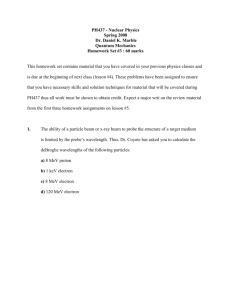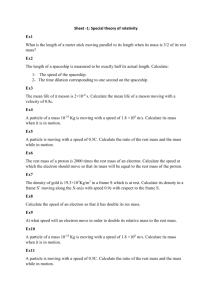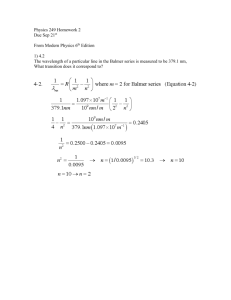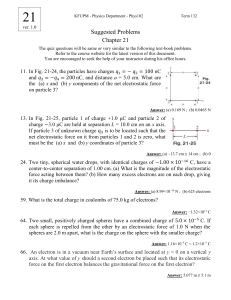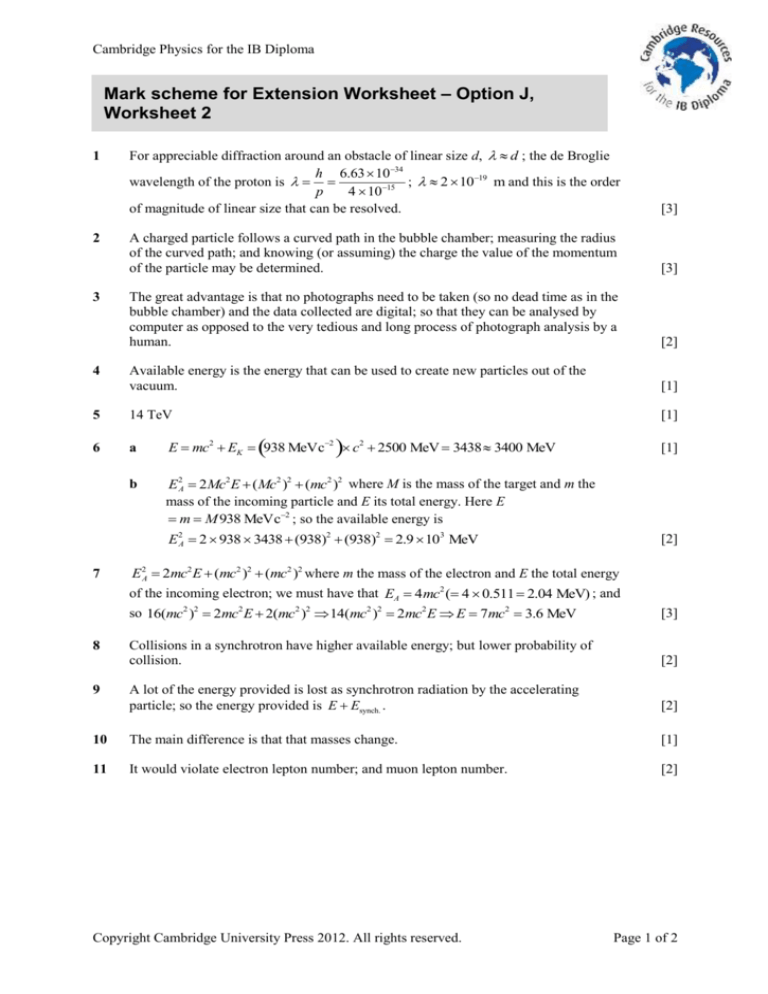
Cambridge Physics for the IB Diploma
Mark scheme for Extension Worksheet – Option J,
Worksheet 2
For appreciable diffraction around an obstacle of linear size d, d ; the de Broglie
h 6.631034
wavelength of the proton is
; 2 1019 m and this is the order
p
4 1015
of magnitude of linear size that can be resolved.
[3]
A charged particle follows a curved path in the bubble chamber; measuring the radius
of the curved path; and knowing (or assuming) the charge the value of the momentum
of the particle may be determined.
[3]
The great advantage is that no photographs need to be taken (so no dead time as in the
bubble chamber) and the data collected are digital; so that they can be analysed by
computer as opposed to the very tedious and long process of photograph analysis by a
human.
[2]
Available energy is the energy that can be used to create new particles out of the
vacuum.
[1]
5
14 TeV
[1]
6
a
E mc2 EK 938 MeVc2 c2 2500 MeV 3438 3400 MeV
b
E 2A 2Mc2 E (Mc2 )2 (mc2 )2 where M is the mass of the target and m the
mass of the incoming particle and E its total energy. Here E
m M 938 MeVc2 ; so the available energy is
1
2
3
4
[1]
E 2A 2 938 3438 (938)2 (938)2 2.9 103 MeV
7
[2]
E 2A 2mc2 E (mc2 )2 (mc2 )2 where m the mass of the electron and E the total energy
of the incoming electron; we must have that EA 4mc2 ( 4 0.511 2.04 MeV) ; and
so 16(mc2 )2 2mc2 E 2(mc2 )2 14(mc2 )2 2mc2 E E 7mc2 3.6 MeV
[3]
Collisions in a synchrotron have higher available energy; but lower probability of
collision.
[2]
A lot of the energy provided is lost as synchrotron radiation by the accelerating
particle; so the energy provided is E Esynch. .
[2]
10
The main difference is that that masses change.
[1]
11
It would violate electron lepton number; and muon lepton number.
[2]
8
9
Copyright Cambridge University Press 2012. All rights reserved.
Page 1 of 2
Cambridge Physics for the IB Diploma
12
a
the reaction is μ e νe ν μ for each neutrino.
b
A Feynman diagram is:
[2]
electron
Electron
antineutrino
muon
W- boson
Muon
neutrino
13
14
15
16
17
W boson; muon–muon neutrino line; electron–electron antineutrino line
[3]
a
hadron
[1]
b
photon
[1]
c
lepton
[1]
Choose three from: quarks exist and gave fractional electric charge; gluons exist and
are electrically neutral; there are three types of colour for quarks; quarks behave as
free particles when probed at high energies.
[3]
Asymptotic freedom means that when probed at high energies quarks inside hadrons
behave as free particles; evidence for this comes from deep inelastic scattering
experiments where the leptons scattering off hadrons appear to be bouncing off
loosely connected quarks.
[2]
3
kT 2mc 2 ; and so
2
4mc2 4 0.51110 6 1.6 10 19
T
7.899 10 9 8 10 9 K
23
3k
3 1.38 10
[2]
It is believed that in the very early universe there was a slightly greater number of
particles than antiparticles; particle antiparticles pairs annihilated into photons and
photons materialised into particle antiparticle pairs maintaining an equilibrium of the
numbers; but as the universe expanded and the temperature dropped (below 8 × 109 K,
see previous problem) particle antiparticle pairs continued to annihilate but photons
could no longer produce particle antiparticle pairs; and so what has been left behind
today is just the excess of particles that were originally present.
Copyright Cambridge University Press 2012. All rights reserved.
[4]
Page 2 of 2



